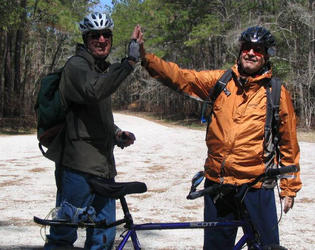But at 11 a.m. Saturday, in the soft, warm sands of the Outer Banks, the long hike of Frank Potter and Jim Walters finally came to an end. The Charlotte golfing buddies became only the 14th and 15th people to complete the nearly 1,000- mile Mountains-to-Sea Trail.
The trail winds from Clingmans Dome – which towers over North Carolina's western border – to Jockey's Ridge, the tallest sand dune on the Atlantic Coast. That's where the pair finished.
Walter's wife and children planted a sign at the 140-foot-tall summit of the dune: “Congratulations Jim and Frank for 1,000 miles of hiking!”
Between the mountains and coast, by their count, Potter and Walters hiked 600 miles and biked 388. Invested 56 days and 22 weekends. Spent untold nights camping or in motels, but exactly seven nights “mooching off others.” Gobbled 40 Subway sandwiches (they travel well). Got lost too many times to count, sometimes with no water.
Witnessed three miracles.
And emerged with a lifetime of memories and a firmly intact friendship.
“The thing I learned about this is how you personally react when things are not going well. It tells you a lot about yourself,” says Walters, 63, a retired banker who sells golf equipment online.
Potter, 66, the longtime general manager of Brodt Music Co., deadpans: “We know a whole lot about each other that we wish we didn't know.”
The guys borrowed camping equipment and bikes, training on treadmills and by wearing backpacks while mowing the grass. None of which prepared them for the first hike.
Like an online version of Lewis and Clark, they kept a trail journal:
When our packs were the heaviest and this was just the beginning – this about killed us. We consumed a lot of water in the first two miles. Being two old guys we were not in condition to descend for five miles on a trail. Knew while we were doing this our muscles were really going to hurt the next day (and boy did they!). Clingmans Dome, July 6, 2007.
A few months later the two found themselves lost in a mountain wilderness area, crawling on hands and knees across a ravine, in the dark, without food or camping gear.
All of a sudden I spotted an old paper cup, then an old beer can and then a bottle. I had never been so happy to see highway litter in my life. As we kept climbing we could finally see a highway guard rail. We pulled ourselves over the guard rail at 10:00 and only had about 1/10 of a mile to our car. We arrived at the campsite at 10:30 and had dinner at 11:30 PM and went to bed very tired, sore and with scratches all over our hands and legs. Bearpen Gap, Oct. 26, 2007.
Last spring they hiked through the eerie remains of a forest fire in the Linville Gorge wilderness.
The hike was quite interesting as the views were spectacular and with many large rock formations. About 1/3 of the hike was through areas that were burned during a spring forest fire. This made for a strange area – no tree canopy, no undergrowth and the granite rocks were turned white from the fire. Table Rock, May 31, 2008.
The 935-mile trail – ferry rides, side hikes to scenic overlooks and campsites lengthen it to nearly 1,000 miles – was authorized in 1973, but volunteers are still carving the path. About half is now foot trail and half follows roads, which Potter and Walters biked.
The trail winds across national parks, rivers and swamps, through small towns and down mountain ridges.
“It really is challenging, just the logistics of it,” says Kate Dixon, executive director of Friends of the Mountains-to-Sea Trail. “People who are willing to take it on put a lot of effort into it, as these guys showed.”
Potter and Walters put thousands of miles on their cars to reach trailheads and shuttle food and gear from the start to end of trail segments.
“On the good side, we've seen so much of North Carolina and some of the hikes are just absolutely great,” Walters says. “I looked forward to getting back out there.”
Lessons learned the hard way: Replenish water supplies at every chance. Stake down your tent. Carry a flashlight with good batteries.
The pair landed on Ocracoke Island by ferry Monday morning for the last 84-mile stretch up the Outer Banks. Potter and Walters endured swarms of mosquitoes at one stop, and had to wade into the surf around protected bird nesting areas, but otherwise escaped calamity.
But as they chat before that last leg, Walters mentions a new challenge. Called the South Beyond 6000, it encourages hikers to climb 40 Southern Appalachian peaks that are over 6,000 feet high.
“That could be our next adventure,” Walters says.
Potter pauses only briefly.
“I could be up for that.”

